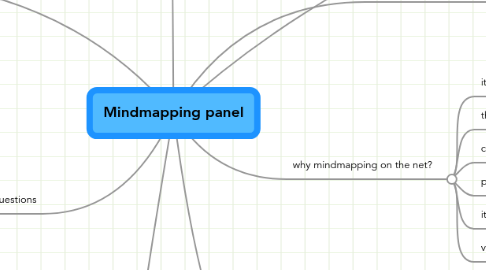
1. introduction
1.1. moving from an area of personal to team productivity
1.2. the value of tacit knowledge has grown very much
1.3. retirement - the entire workforce will be considered too valuable to walk off the stage too soon
2. questions
2.1. people taking up when no one is pushing?
2.2. why be limited to the kind of mapping that can be done on paper and replicate it to computers?
2.3. panama has made it cosnstitutionally mandatory for children to learn? (Martin - to follow up with him for references)
2.4. what does it tkae of mm to become mainstream in business
2.4.1. constitutional mandate ? :D
2.4.2. people realize that they are able to unlock ideation
2.4.3. mindmapping is a situational applications
2.4.3.1. it's coming into organizations thorugh people who see if with others
2.4.3.2. user generated
2.4.3.3. it will happen naturally
2.4.4. children use it now and grow up with it
2.5. what are the other companies doing to go web 2.0
2.5.1. collaboration online
2.5.2. what MindManager does on the desktop can be done on the web
2.5.3. discovery of info on the web that pertains to this mindmap
2.5.4. switching between different types of visualization
2.6. mindmapping not so freeform as pure paper - much nicer - much closer to the philosophy
2.6.1. much more compelling tools come up - a lot to choose from
2.6.2. look at stuff like concept share; visual thinking
2.6.3. visual thesaurus
2.7. evangelizing
2.7.1. getting people to come into
2.7.2. putting value / content into the map
2.7.2.1. business practicality
2.7.3. context - form there into other parts of the organization
2.7.4. collaboration - process
2.7.4.1. now they use they same process for each new account
2.7.5. start using the map with customers as they are doing the sales discovery process; co-creationg between customer and sales people...
2.7.6. the customer gets the proposal in a map - they co-created it
2.7.7. cutting sales cycle a lot
3. SnapXT
3.1. taking a map and doing stuff with it
3.2. allowing people to take a map and generate collaborative websites
3.3. they were using MindManager as the front end
3.4. clients are using it in 2 ways:
3.4.1. virtual teams with completely custom projects
3.4.1.1. create project in a mindmap
3.4.1.2. generate a complete website of that from the click of a button
3.4.2. creating a body of knowledge
3.4.2.1. legal firm in real estate law
3.4.2.2. mapped out the legal information in this area
3.4.2.3. to get to the website content, they use a mindmap
3.5. bi-directional nature
3.5.1. bringing stuff back into a map and working on it there
3.5.2. the tool is good for its connectiveness to the next stage of collaboration
4. normalizing mindmapping as a normal business application
4.1. re-arranging ideas is a very good way to get to the core of a theme
4.2. encouraging loose thinkging - they allow for possibilities in connections
4.3. concept mapping is something else
4.3.1. a reflection of language
4.3.2. non-hierarchical form
4.3.2.1. no main idea
4.3.3. if you give your mindmap to another person, he /she might not be able to do a lot with it
4.3.4. mindmaps are great for computers because of the semantic clarity
4.3.4.1. add a thought
5. value of mapping and collaboration
5.1. lots of personal use
5.2. visualizing the big picture
5.3. being able to manage a larger number of R&D projects
5.4. collaborating in innovation
5.5. bringing together disparate groups
5.6. companies using for sales - co-creationg of content with customers
5.7. strategic planning
5.8. examples
5.8.1. US army
5.8.2. research to combat bird flu
5.9. SnapXT - ability to create a disposable application, generating websites with not technical knowledge at all
6. why mindmapping on the net?
6.1. it seems like an obvious choice!
6.2. the team put up up the map of this panel on MindMeister
6.2.1. but it doesn't look like it is public... or is it?
6.3. co-creating
6.4. people are not usually in an office when they need to collaborate in creating
6.5. it is still important to also have a direct, voice conversation, instead of just typing away silently
6.6. very important at the start up - visualization can help bridge some language and cultural issues
7. Intensil
7.1. the question of ROI for enterprise 2.0
7.2. going from ideation to something repeatable
7.3. the customers made them implement mindmapping as an input device
7.4. creating instant workflow from the output of a brainstorming session
7.4.1. in a non-threatening environemnt
7.4.2. you can always re-organize
7.5. mindmaps get people thinking in a process-oriented level
7.5.1. intuitively, people build maps that translate into flow very well
7.6. if you've been working on a list, inserting things feels threatening because you're disturbing a sequential order; not in a mindmap!
7.7. allowing a team to evolve their thinking as a team
8. new stuff
8.1. Everything is miscellaneous - Weinberger - everything can be a node
8.1.1. if everything is leaves, you can use a mindmap as a structure to pull the trees together
8.1.2. any leaf can be on any tree
8.1.3. in current mindmaps, there is always a central topic - anything should be able to be a central topic
8.1.4. the map is not the territory
